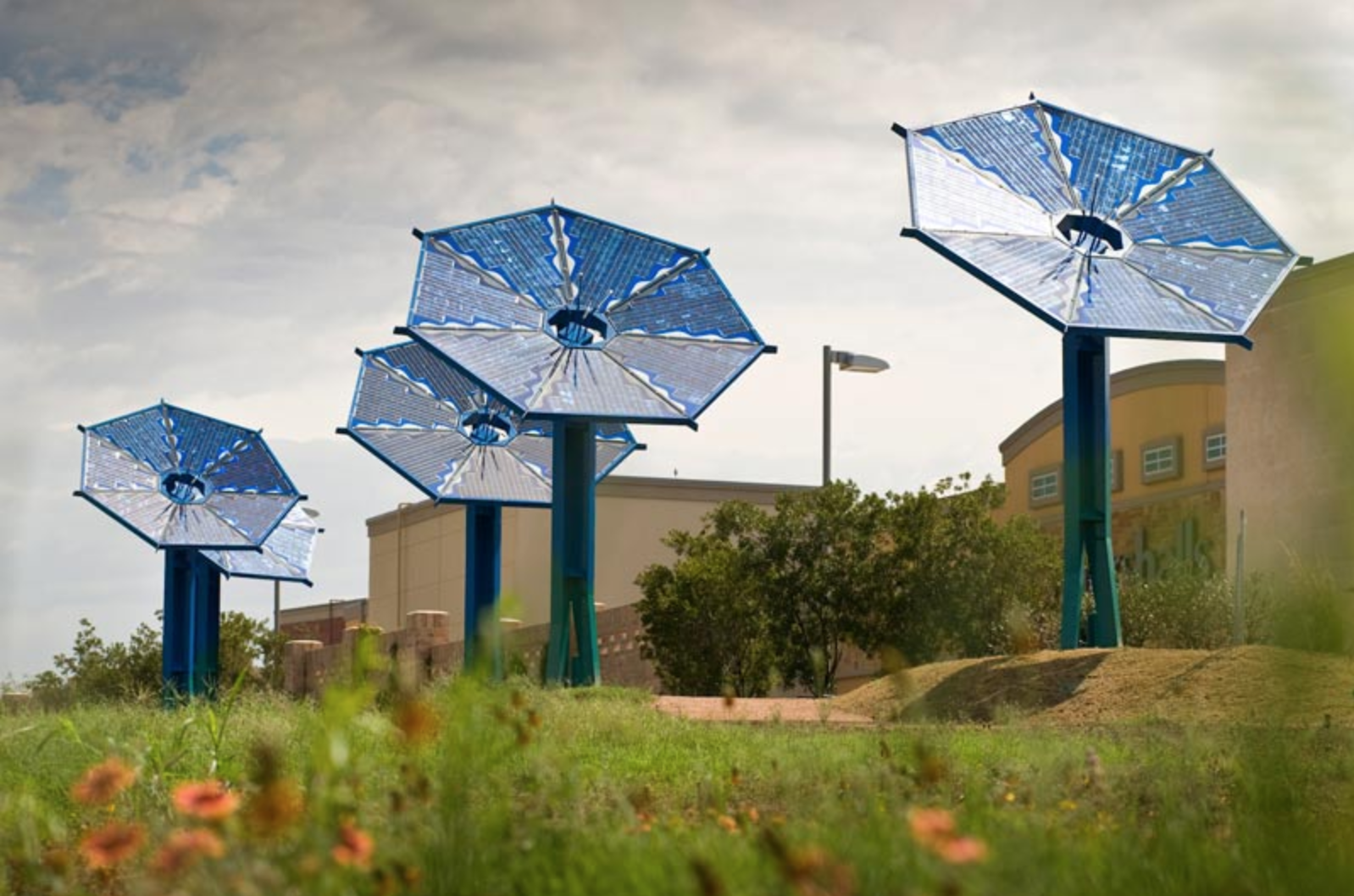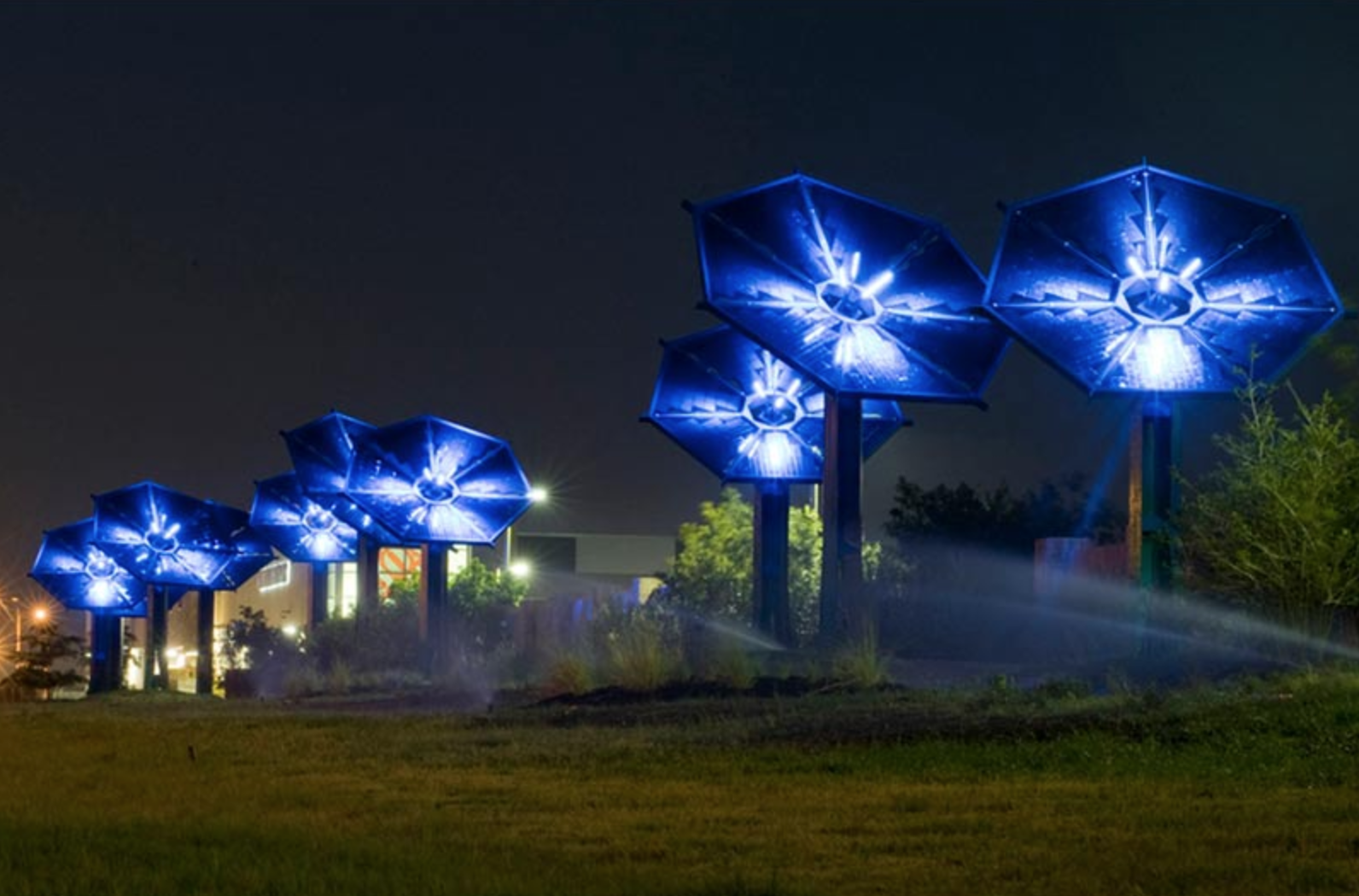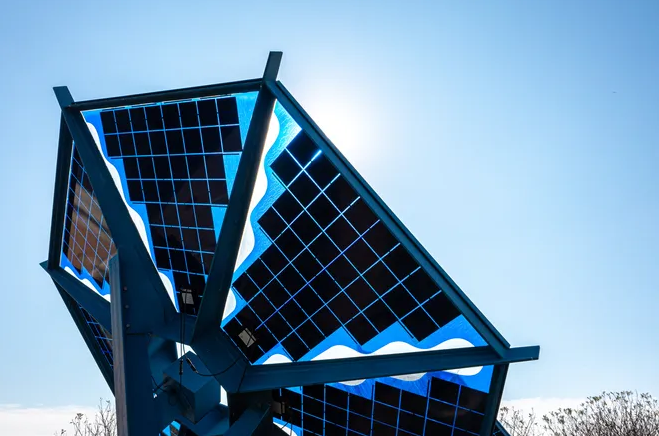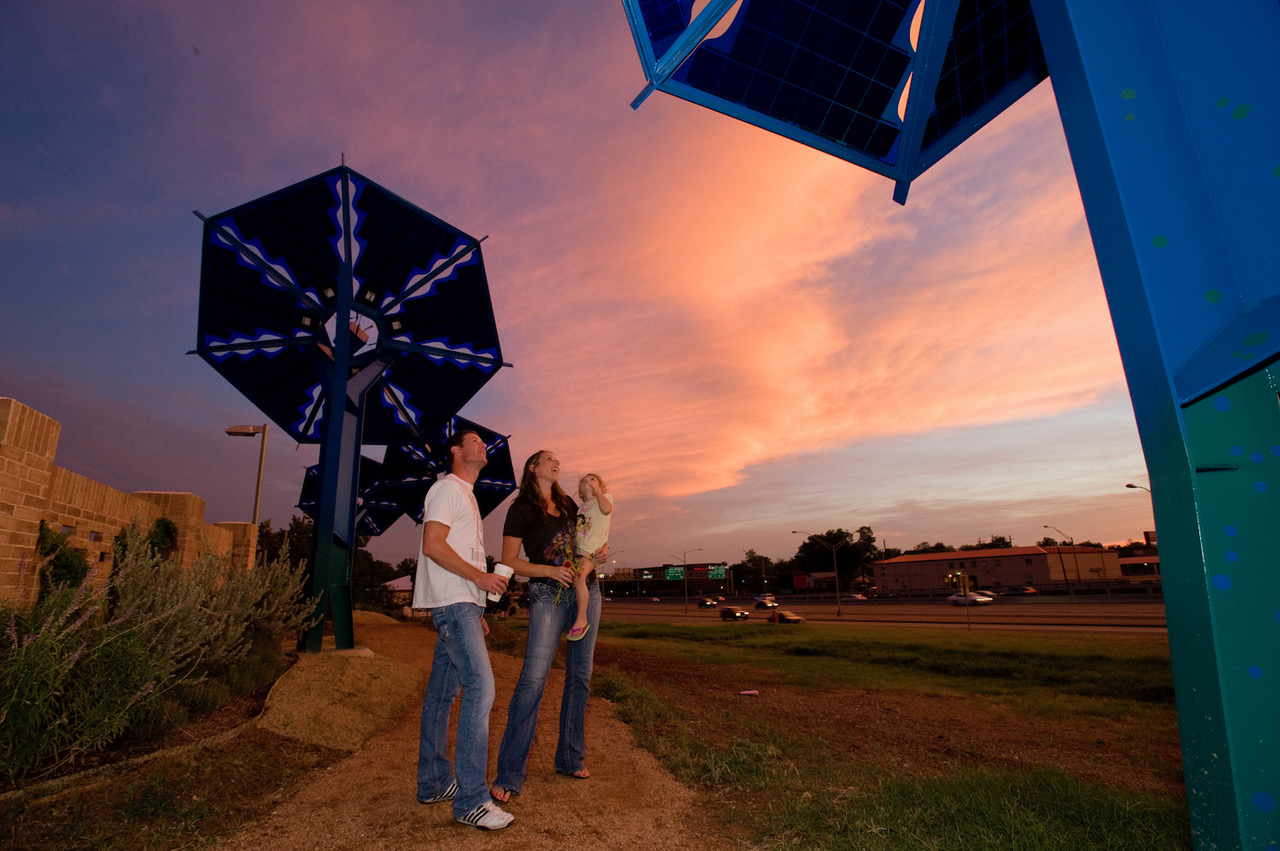
SunFlowers, An Electric Garden, a public artwork wanting to generate solar energy
an interview with Mags Harries and Lajos Héder by Patricia Watts
"The sun sustains all of our lives…. All of our energy is originally solar energy, (and) it has created our world and fuels all our activities. Coal and oil are stored solar energy, but they are running out, and obtaining and processing them causes problems. For our future, it is a question of how we capture and use solar energy, so that it keeps us going without environmental catastrophe. The sun and its light are the medium of most art.” Mags Harries and Lajos Héder
Mags Harries and Lajos Héder are a wife and husband artist/architect duo who have worked collaboratively to create public art works across the United States from their studio in Cambridge, Massachusetts. Since 1990, they have completed over thirty public art projects with budgets up to $6 million. With the upcoming total solar eclipse in the path of totality in Austin, Texas, where Harries and Héder created a solar-powered work titled SunFlowers and where ecoartspace will hold a pop-up event nearby on April 6 at Canopy, we feature an interview with the collaborative team discussing the trials and tribulations of creating a large-scale work in the public sphere addressing energy resilience.

Q. In 2006, SunFlowers was chosen out of 37 proposals for a signature art installation at Mueller, a LEED-certified planned community with eco-conscious mixed-use development, including single-family homes, apartment complexes, as well as retail offices and restaurants. Your solar artwork was selected by the community and was the most popular as well as innovative at the time. I can imagine you were super excited to create a work that was both aesthetically interesting, practical, and self-sustaining. Almost twenty years ago, what were the challenges of creating such an innovative public artwork?
A. Each proposal and or commission we do is always particular to the place. It is important that we observe and see what are the elements that make this place unique. What was unique about the project in Austin, Texas was that the 711 acre former Mueller airport had been transformed as an ecological community development. Of the 37 RFQ applicants, 4 finalists were asked to create a proposal to mask the Big Box companies that had been built on the edge of this development along the major Interstate Highway I-35, a six-lane expressway. This seemed like an impossible task. Rather than mask development, we decided to reinforce what was important about this site, its environmental goals to create a livable community. I-35 runs north-south, perfect to capture solar energy. The site, which is 1000 x 30 feet long, has a substantial easement from the highway that is maintained by state mowing crews. We are not artists that think of making iconic stand alone work but the site was huge and the fast-moving traffic was our audience. We would create an impact that was strong enough to detract from seeing the large box retail. We had a choice. We could create multiple elements that would face in one direction, or the other choice to have one unit that would track the sun that would not have the same visual impact.
We knew nothing about solar technology so we had to find a company that could help us design the system. We had to find someone that could build our solar panels and a glass company that could cut and drill glass. As these pieces would also be experienced from below, it was important that we sandwiched gels in the glass to create a feeling of stained glass when looking up at them. Each of these elements had to be researched and tested. As these were not standard modules they had to be electrically certified. We made ¼ scale models out of foam board to develop the form and then had an engineer to calculate whether the forms were strong enough to resist 100mph winds. As with all our projects we employed local companies to build and paint the forms and engineer the project.
Q. I understand there was a delay in launching SunFlowers, as the flowers did not glow as intended due to complications with the solar panels? Is this something that today would not represent such a problem? with technological advances in the solar industry?
A. There was a lot of research that had to go into this project. I think we would go with the same process at this time, unless we used standard sizes that were already certified. We had many people contact us after the work was officially launched, even a representative of the Chinese government who inquired about making more. Though, this might not have been economically feasible. There are more solar companies and expertise now that might make it easier, and tax incentives that did not exist then. We pushed the boundaries by making a non standard shape. Because the public could walk under the panels, the glass had to be laminated. The colored gels were also special. It was important that the underside of the panel would be beautiful.
We never repeat a project elsewhere, so we would have had to redesign a different form, perhaps with a different shape of solar. Would it have been more economical? Probably not, but we did have command of the process and technology changes all the time. The LED lighting was also specially designed to be brighter.

Q. The Powerdash online monitoring site is currently not working. Is this something you feel strongly should be relaunched? How long was it tracking the energy generation? And, what is the current generation, kilowatt-hours each year?
A. The Powerdash online monitoring system was funded after the project was up by another grant so that schoolchildren could monitor how much energy it was creating. It was measuring 1800 KW hours per year. Anne Graham, who worked with the city was responsible to get that grant. From an article she found, over a nine year period SunFlowers had generated 386,006 kWh, the equivalent of 565,000 miles of carbon emissions from a car.
Q. The 15 Sunflowers are considered one of the largest public art works in the City of Austin and had a budget over $600,000, fifteen years ago. Do you think it would cost the same today?
A. I am not sure what it would cost today as these were all specially cut and designed. There are more solar companies today, though are all using standard fixtures. Perhaps it would be harder to find collaborators as there is more demand as people are installing more and more solar units on their homes. This project was done at a time that solar was not as popular and certainly not experienced as an art project.
Q. Has the project received any awards? It seems like the Public Art Network should have recognized this work.
A. I think the only award was the Livable City Vision Award in 2010 (Austin, Texas). Because this was administered by the city public art program, they never recognized it as theirs. And, the city did not submit SunFlowers to the Americans for the Arts, Public Art Network Conference.
Q. The selection process was coordinated through the city’s Art in Public Places program, but the development is private, owned by Catellus Development Group. How common is this arrangement? I know most of your public art projects have been coordinated through city programs. Was working with a private developer easier or more complicated?
A. We have one other project similar to this in Philadelphia titled Light Play (2016), also administered by the city public art program for a private developer on a building in the arts district. I do not know how many cities demand such a partnership. As the public art field is hard and there is high turnover in administration, maintenance records, which we always provide can get lost. On this project our same point person is still with the company. We have direct contact with him. Oftentimes city agencies do not have a maintenance budget, or someone employed by the city to maintain public art pieces. Perhaps a private company has more incentive to maintain a public artwork.
Q. From your artist statement for SunFlowers you state that the sun and its light are the medium of most art, can you expand on this concept?
A. Projects that came after SunFlowers include Light Gate (2015), Light Play (2016), and Xixi Umbrellas (2012), which are also all directly related to the sun and light. Engaging the sun allows there to be a daily change of perception. In a city like Austin, it was amazing how few people were installing solar power. It seemed we were selected because the city saw itself as forward looking, all the other artists proposed Texas stereotypes. I am sure we were also aware that it was a good move to demonstrate that Catellus had created a new environmentally friendly development from an old airfield.

Q. There are organizations that focus on technology based artworks to offer inspiration and practical applications for energy generation, such as the platform called Land Art Generator, directed by Robert Ferry and Elizabeth Monoian. I was a panelist for their Freshkills Park (Staten Island, NY) awards in 2013, and wrote an essay for their Powering Places (Santa Monica, CA) initiative in 2016. Something that concerns me with technology-based art is that it can often be a way to entertain more than a real world impact, by reducing our need for fossil fuels. For you, what percentage of this type of work should be art or entertainment and how much supporting ecological systems? What would be the best balance?
A. Rarely do we do work on this scale. But we were dealing with a huge highway, it had to have scale to be significant. It was important to us that it actually harvested energy and that one of the seven panels of each illuminated the flowers at night. It had to be iconic. Power dash was a way that children could monitor it so in that way it was a teaching tool, not entertainment. Change is important to this piece to see it during the day, then at night. The other thing we extended our site to include the large mowed grass embankment. We planted seeds from the Ladybird Johnson Foundation so that this “no man’s land” would burst with wildflowers. We also negotiated with the State Highway crews to only mow after the flowering season. This piece is not only experienced from the highway but it also has an inter-twining walking path between the SunFlowers. And, the path connects two open spaces parks within the development. Do these actions create change? I am not sure, but it is important to embrace something that one believes in.
Having had a recent conversation with Leo Lopez at Catellus who told us that the inverters had been stolen, which at a minimum would cost $100,000 to replace, it is sad that Sunflowers can no longer harness energy. They will, however, be sure that the flowers will be lit at night, though from an electric source and not by its own energy. So perhaps now fourteen years later they exist as a symbol rather than generating their own energy. This does not make us happy, but hopefully they will still be an important landmark for Austin. The sad part of public art it is that it is out there in the elements and so many of our projects have little budgets to restore and maintain them. What is important is that Catallus cares to maintain them. In that way the SunFlowers are successful.
Mags and Lajos, thank you for sharing about your experience with this inspiring solar work.
NOTE: As of today, led by California, rooftop solar installations fell by 12 percent nationally in 2023. It’s the first decline since 2017. It is estimated that California, which accounts for the bulk of the United States market, will see a 41 percent drop in 2024. Over 100 solar companies filed bankruptcy in 2023. (Article published January 26, 2024, Grist)